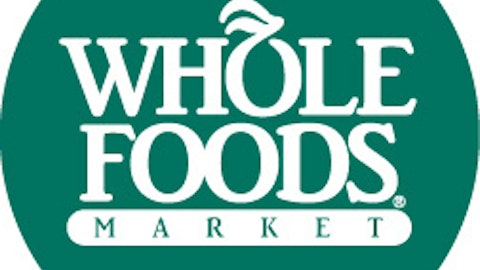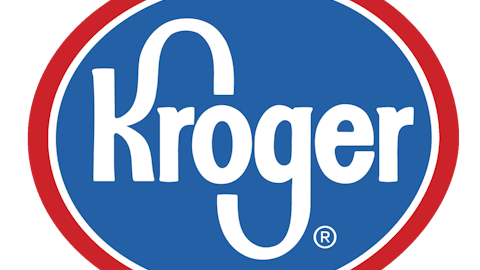I’m going to attempt something a little odd today, Fools. Even though Whole Foods Market, Inc. (NASDAQ:WFM) makes up 7% of my real-life holdings, and I recently wrote about why I’m holding Whole Foods stock in my retirement portfolio, I’m going to be giving you three reasons to consider selling the stock today.
Why am I doing this?
Earlier this year, Nobel Prize winner Daniel Kahneman visited Fool HQ in Virginia. While visiting, he talked about how a number of different biases can lead us to believe we can predict the future with relative certainty. In reality, he argued, we are just deluding ourselves.

Source: David Shankbone, via Wikimedia Commons.
It got me to thinking about how I don’t write enough about the risks of owning the stocks I own. So, though I don’t plan on selling my Whole Foods stock anytime soon, I think it’s healthy for me to practise and model this behavior.
1. The competition is catching up.
Two years ago, I did a little experiment. While many people referred to Whole Foods Market, Inc. (NASDAQ:WFM) as “Whole Paycheck” because of the price of the company’s food, I thought the moniker wasn’t fair. Organic food is almost always going to cost more than the conventional variety.
And as you can see here, in 2011, Whole Foods’ organic price points were far superior to those of Safeway Inc. (NYSE:SWY) and Harris Teeter Supermarkets Inc (NYSE:HTSI) and others. Organic food bought at Whole Foods was — on average — about 27% cheaper than the competition.
But I repeated this experiment this summer, and things have changed. Safeway Inc. (NYSE:SWY)’s decision to go all in on its O-branded organic line has helped it pull into a virtual tie with Whole Foods Market, Inc. (NASDAQ:WFM) from a pricing point. And Roundy’s Inc (NYSE:RNDY) is experimenting with a new type of Whole Foods-esque grocery store dubbed Mariano’s Fresh Market. This, too, was able to offer organic goods at prices points virtually identical to those of Whole Foods.
If this trend continues, savvy customers may choose to patronize the competition more often, which could slowly erode Whole Foods Market, Inc. (NASDAQ:WFM)’s business.
2. It’s an expensive stock.
Let’s say that, over time, Whole Foods is still able to maintain solid revenue streams in the face of mounting pressure. Even if that’s the case, it doesn’t mean Whole Foods stock is a great pick for your portfolio.
As it stands now, Whole Foods Market, Inc. (NASDAQ:WFM) — along with Harris Teeter Supermarkets Inc (NYSE:HTSI) — is the most expensive of the major U.S. grocers. Take a look at how the company stacks up in terms of both price-to-earnings and price-to-free cash flow.
| P/E | P/FCF | |
|---|---|---|
| Whole Foods | 38 | 25 |
| Harris Teeter | 25 | 85 |
| Roundy’s Inc (NYSE:RNDY) | N/A | 6 |
| Safeway | 9 | 7 |
| Kroger | 13 | 24 |
Source: Yahoo! Finance, SEC filings. N/A=Not available due to negative earnings or free cash flow.
As it stands, Whole Foods Market, Inc. (NASDAQ:WFM) has a little more than one-third of its public goal of 1,000 North American stores. That means there’s a lot of room for growth, both in terms of stores and increasing same-store sales.
But much of that potential is already baked into the stock, and investors need to carefully consider what any sign of declining growth could mean for the stock’s price.
3. The rise of… farmer’s markets?
I’ll admit that at this point this risk might seem a little far-fetched, but indulge me for a minute.
Many of Whole Foods’ customers are very conscious of where their products come from and how they were grown/raised. More than 31% of Whole Foods’ products come from a single vendor, United Natural Foods, Inc. (NASDAQ:UNFI). Though Whole Foods goes out of its way to get local produce in its stores, the fact remains that there’s still a lot of food that’s reliant upon using lots of petroleum to ship it to customers.
One way that eco-conscious shoppers can cut down on the carbon footprint of their food is via farmer’s markets. And though they represent just a small fraction of all food sold, farmer’s markets are in the middle of a meteoric rise in popularity.

Source: USDA.
Should this wave continue indefinitely into the future, the very eco-conscious customers who were attracted to Whole Foods’ organic message could leave in favor of the localvore movement (only eating things grown locally).
What does this mean for Fools?
I’ll admit that reviewing these risks — particularly the first two — are sobering reminders for me that Whole Foods Market, Inc. (NASDAQ:WFM) stock has serious obstacles in its path. That being said, I think it is the leader of one of the greatest, most sustained movements we’ve ever seen outside of technology — rebalancing a fundamental shift in how we relate to our food that changed after World War II. Though I’m not buying new shares now, I’m certainly not selling anytime soon, either.
The article 3 Reasons to Sell Whole Foods Stock originally appeared on Fool.com and is written by Brian Stoffel.
Fool contributor Brian Stoffel owns shares of Whole Foods Market (NASDAQ:WFM). The Motley Fool recommends and owns shares of Whole Foods Market.
Copyright © 1995 – 2013 The Motley Fool, LLC. All rights reserved. The Motley Fool has a disclosure policy.






